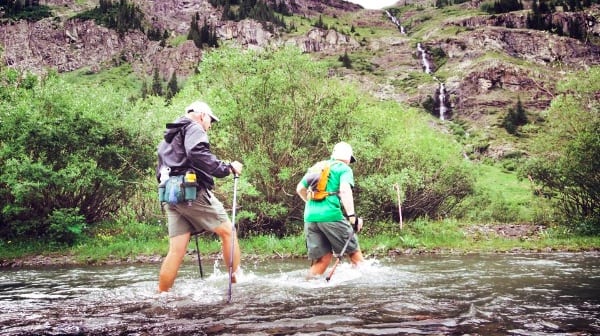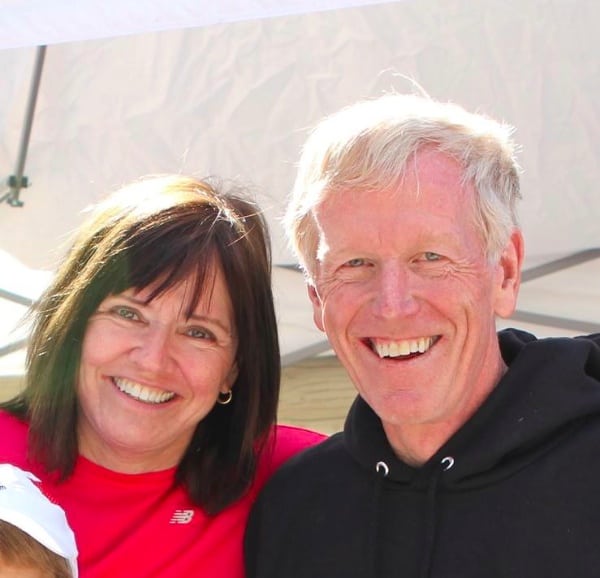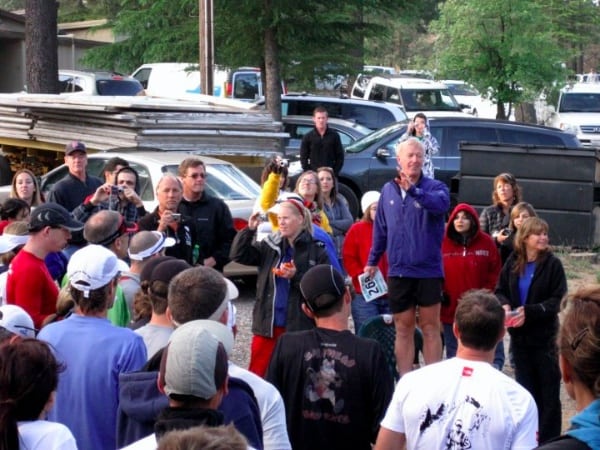After a long day of college classes and coaching the local swim team, I sat down on my bed to talk with WeRunFar’s October profile, Scotty Mills. At 63 years old, Scotty has run over 200 ultras—the exact number is unknown since he was competing in races before UltraSignup was established. My pen flew across numerous pages of my notebook, taking down historical facts, numbers and dates, and tips on how to run a successful race. Within the short time I was talking to Scotty I realized I was back in class, Ultrarunning 101.
As a mentor to many, and a friend and fellow runner to others, to me, Scotty felt like my professor. An expert in the ultrarunning field, he is the guy that has seen and done it all, the one to answer all of my questions, and hopefully not grade too harshly on my next race performance.
Scotty has it down to a science. His formula, designed and tweaked throughout the last 30 years, has allowed the veteran runner to complete 37 100 milers, 10 100ks, and an unknown number of 50ks and 50 milers. It involves resting during his ‘off-season’ (the months of October to December), listening to one’s body, and sticking to one or two keys races a year.
“You have to respect the human body,” he said. “This sport is hard. If you don’t rest and look at the overall picture, your time is limited.”
This formula and mindset allowed Scotty to run both the Hardrock 100 and The North Face Ultra-Trail du Mount-Blanc this past year. It has also certifies that, when given the opportunity to talk to Scotty about running, you better listen.

Scotty speaking alongside fellow Western States experts during the 2011 screening of the film ‘Unbreakable.’ Photo: Monica Morant
According to Bryon Powell of iRunFar, Scotty is no stranger to the student-and-teacher relationship.
“He IS my ultrarunning mentor,” Bryon said in an email. They met at the Bull Run Run 50 Mile in Virginia in the early 1990s. Scotty was the substitute director of the race while the founder of the race went overseas, and Bryon was just getting his feet wet in the ultra world by volunteering.

Bryon Powell and Scotty showing off their finisher buckles after the 2006 Western States 100. Photo: Sophie Speidel
Whether it was tips for the trail, like the “Scotty Shuffle” (switching from walking to running based on the trail terrain) or presenting step-by-step directions on how to master the Western States 100, Bryon said Scotty shares every ounce of knowledge he has gathered throughout his 30 years of running.
It started in 1982, after watching runners sprint past the window of his Sacramento, California home. Coincidentally, his house butted up against the trail used by the participants of the American River 50 Mile. The next year, Scotty’s name was on the entrants list and his feet never left the trails again.
Scotty was born in Berkeley, California but made an early move to Portland, Oregon, then New Jersey during his high-school years. He attended college in Colorado at the United States Air Force Academy on a soccer scholarship.
“After Air Force college, I felt like I needed to stay fit,” Scotty said. Chasing after something—a ball, a girl—was the only running Scotty engaged in before becoming the ultra wiz he is now.
“My wife was a jogger when I met her,” he said. “So, to date her, I had to jog. But I realized that I felt good and began to love it.”
After spending 22 years in the Air Force, where he was mostly stationed in Virginia, Scotty and his wife, Jean, stayed in the state for the next 10 years. In 1980 they decided to return to the West Coast, settling in California.
It only took one year before Scotty was on the trails of Western States, but his passion for the sport had already begun.
I would train up in the Sacramento mountains,” he said. “I found my love of the sport, the beauty, the people, and the distances that others thought were absurd.”
A self-proclaimed mountain runner, Scotty’s successful career comes from accepting and playing to his own strengths.
“I am not fast or competitive, in that I have never won an ultra,” he said, though 17 sub-24-hour-100-mile belt buckles, and one top-10 WS100 finish are not stats to browse over. “Longer races that build mental tenacity, especially mountain runs, are my favorite.”
Mental toughness is Scotty’s strong suit, according to his wife, who has built up her own mental hardness through the years of crewing.
“He is very mentally tough,” she told me, laughing through the phone. “It is his strongest attribute. He will go on through when normal (or sane) people stop. He is unbelievable.”
Though, she says she will leave the ultras to Scotty, Jean is on the sidelines of nearly every race of his.
“You get drawn into it,” she said. “The people, trails, the support and crew of friends and family. It is the experience of ultrarunning.”
Though accused by Jean that he may “overdo it” sometimes, Scotty knows what it takes to ace or flunk a race. And this past year was the ultimate test.
Two slight spur-of-the-moment decisions led Scotty to his sixth running of Hardrock and his first encounter with UTMB. Though used to the extreme conditions, Scotty knew he had to prepare for the Colorado race.
“To do well at Hardrock, at my age, I am a firm believer you have to be acclimated to the altitude,” he said, just one way to help prep his body. He went out about three weeks before the start of the race to run different sections of the course. Scotty focused on running the race smartly and taking advantage of having a pacer the entire race, an option given to participants over the age of 60.
“I approached the race with my older age in mind,” he said. “I wanted to run strong, but not overdo it, and save for recovery.”

Scotty and his pacer leaving the Cunningham Aid Station during the 2014 Hardrock 100. Photo: Dominic Grossman
Though the weather was difficult, Scotty said he dealt with it like any other race. He easily moved up through the field, finishing the race in 28th place for a personally satisfactory time of 36 hours, 27 minutes, and 51 seconds.
Leading up to the race, Scotty took part in the training camp where he was asked by Karl Hoagland to join a group of runners preparing to run UTMB.
Agreeing to the trip, Scotty said he would go just to be there, and planned on hiking and running the new adventure rather than truly competing.
“I was really concerned with having only seven weeks till UTMB,” he said. For someone who believes that total recovery for a 100 miler consists of one day of rest per every mile, Scotty had to redesign his typical recovery schedule. He spent the next two weeks barely running, and then slowly built up the mileage. He tapered back down, arrived in France feeling recovered, and crossed the finish line happy and exhilarated.
Surprisingly, he finished one minute faster than his Hardrock time and four hours faster than his self-predicted time.
“UTMB was the most memorable event of the year,” he said. “It was just amazing. I remember the climb up the mountains at night and looking back down. It was a long conga line of headlamps ‘serpentine-ing’ up the mountain. Just magical.”
According to the experienced runner, it was a great summer of racing. Though, the times were not the fastest, he noted, they were races that required an extreme amount of effort.
“The European experience was really special,” he said, but still admits Hardrock will always hold a special place in his heart. “Hardrock is an iconic event. It is a family race. People compete together against the course. You run over the most scenic, beautiful mountains in the country. It just has the whole package.”
We hear about the ‘family’ of ultrarunning a lot, whether it involves the community in general, or within a specific race. Scotty embraces both. As the race director of the San Diego 100 Mile Endurance Run in Lake Cuyamaca, California, Scotty believes having a strong circle of friends and family is the key to a successful race.
“We try to instill that family aspect,” he said, describing his race as “an experience for runners, by runners.”
Scotty inherited the race six years ago from Paul Schmidt, who knew he was leaving the race in good hands. Schmidt knew Scotty’s vision for the race would be the best way to build and grow the event.
Once under his direction, Scotty changed the San Diego course, making it into a more mountainous trek. The route travels through several ecosystems and includes sections of the Pacific Crest Trail, Laguna Mountain Recreation Area, and Noble Canyon.
“Before I decided to take over, I had to feel like I had the power to delegate and put on a race with the same standards as a good 100 miler,” he said. Modeling San Diego after Western States and Hardrock, Scotty incorporates a lottery system and caps off the race at 250 people, a number he feels is best for the enjoyment and safety of the runners.
“For me, my goal as a race director is to get the highest finishing rate of runners,” he explained. A 100 percent finishing rate is the ultimate goal, yet Scotty knows the impossibility of that. Instead, he strives on finding the line between motivation and pushing people beyond their limits.
“[Directing] is a lot of hard work if you do it right,” he said. “ You can easily overdo it, but I find as much enjoyment as running an ultra as I do putting one on.”
Looking at the syllabus for mid-October, we find Scotty taking his obligatory downtime to rest physically and mentally before starting over again in January.
This time includes easy, watch-less runs in the mountains, and watching other runners embark on their own adventures, such as iRunFar’s Meghan Hicks during her Tor des Géants race in September (her report).
“I was glued to Meghan’s race. I thought, Wow, I wonder if I could do that?” he said, also mentioning the slow shaking of Jean’s head in the background as he speaks.
It is this fear of missing out, or as Scotty calls it, “FOMO,” that keeps his name on the sign-up lists of new and already completed races. However, he knows that running will not always be the viable option.
“You cannot run forever,” he stated. “But you can stay active in the community even if [you’re] not running.”
For Scotty this means volunteering, crewing, and continuing as an RD. It also means having the opportunity to pass down the knowledge he’s gained to the beginners in the field. And amateurs, if they’re like me, would be in the top row of seats, pen poised, and arm constantly raised, ready to learn from the best.
Call for Comments (from Meghan)
Scotty Mills is a bounty of knowledge for many, a jokester to even more, and an icon to all in the trail and ultrarunning community. Many of us have stories about this guy, so it’s time to let ‘er rip and roast Scotty. Do tell!









